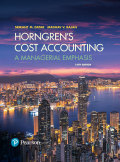
Equipment replacement decisions and performance evaluation. Susan Smith manages the Wexford plant of Sanchez Manufacturing. A representative of Darnell Engineering approaches Smith about replacing a large piece of manufacturing equipment that Sanchez uses in its process with a more efficient model. While the representative made some compelling arguments in favor of replacing the 3-year-old equipment, Smith is hesitant. Smith is hoping to be promoted next year to manager of the larger Detroit plant, and she knows that the accrual-basis net operating income of the Wexford plant will be evaluated closely as part of the promotion decision. The following information is available concerning the equipment-replacement decision:
| Old Machine | New Machine | |
| Original cost | $900,000 | $540,000 |
| Useful life | 5 years | 2 years |
| Current age | 3 years | 0 years |
| Remaining useful life | 2 years | 2 years |
| $540,000 | Not acquired yet | |
| Book value | $360,000 | Not acquired yet |
| Current disposal value (in cash) | $216,000 | Not acquired yet |
| Terminal disposal value (in cash 2 years from now) | $0 | $0 |
| Annual operating costs (maintenance, energy, repairs, coolants, and so on) | $995,000 | $800,000 |
Sanchez uses straight-line depreciation on all equipment. Annual depreciation expense for the old machine is $180,000 and will be $270,000 on the new machine if it is acquired. For simplicity, ignore income taxes and the time value of money.
- 1. Assume that Smith’s priority is to receive the promotion and she makes the equipment-replacement decision based on the next one year’s accrual-based net operating income. Which alternative would she choose? Show your calculations.
Required
- 2. What are the relevant factors in the decision? Which alternative is in the best interest of the company over the next 2 years? Show your calculations.
Want to see the full answer?
Check out a sample textbook solution
Chapter 11 Solutions
EBK HORNGREN'S COST ACCOUNTING
- Nonearrow_forwardNeed help with this general accounting question not use chatgptarrow_forwardUse the expanded accounting equation to solve for the missing amount. Assets $30,000 Liabilities= ? Owner's Capital, Beginning Balance= $15,000 Revenues $10,000 Expenses $3,000 Withdrawals= $1,000arrow_forward
- Nonearrow_forwardBoom Lay Corp, has a current accounts receivable balance of $327,815. Credit sales for the year just ended were $4,238,720. What is the receivables turnover? What is the day's sales in receivables? How long did it take on average for credit customers to pay off their accounts during the past year?arrow_forwardHi expert provide correct answer general accountingarrow_forward
 Cornerstones of Cost Management (Cornerstones Ser...AccountingISBN:9781305970663Author:Don R. Hansen, Maryanne M. MowenPublisher:Cengage LearningPrinciples of Accounting Volume 2AccountingISBN:9781947172609Author:OpenStaxPublisher:OpenStax College
Cornerstones of Cost Management (Cornerstones Ser...AccountingISBN:9781305970663Author:Don R. Hansen, Maryanne M. MowenPublisher:Cengage LearningPrinciples of Accounting Volume 2AccountingISBN:9781947172609Author:OpenStaxPublisher:OpenStax College Managerial Accounting: The Cornerstone of Busines...AccountingISBN:9781337115773Author:Maryanne M. Mowen, Don R. Hansen, Dan L. HeitgerPublisher:Cengage Learning
Managerial Accounting: The Cornerstone of Busines...AccountingISBN:9781337115773Author:Maryanne M. Mowen, Don R. Hansen, Dan L. HeitgerPublisher:Cengage Learning Essentials of Business Analytics (MindTap Course ...StatisticsISBN:9781305627734Author:Jeffrey D. Camm, James J. Cochran, Michael J. Fry, Jeffrey W. Ohlmann, David R. AndersonPublisher:Cengage Learning
Essentials of Business Analytics (MindTap Course ...StatisticsISBN:9781305627734Author:Jeffrey D. Camm, James J. Cochran, Michael J. Fry, Jeffrey W. Ohlmann, David R. AndersonPublisher:Cengage Learning



